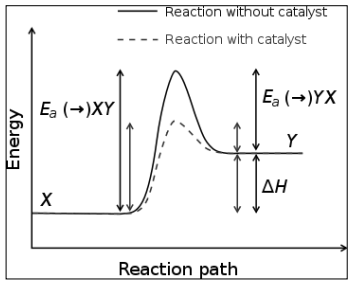UPSC Exam > UPSC Notes > Zoology Optional Notes for UPSC > Concept of Bioenergetics
Concept of Bioenergetics | Zoology Optional Notes for UPSC PDF Download
Definition of Bioenergetics
- Bioenergetics is the study of energy transformation in living organisms.
- The primary goal is to elucidate how living organisms acquire and transform energy for biological work, emphasizing the importance of metabolic pathways.
Energy Transformation in Living Organisms
- In living organisms, energy is exchanged through the breaking and making of chemical bonds.
- Weak bonds are broken, and stronger bonds are formed, releasing usable energy.
- Adenosine triphosphate (ATP) acts as the main "energy currency," synthesized and utilized in metabolic processes.
Energy Charge in Cells
- The ratio of ATP to ADP concentrations in a cell is known as the "energy charge."
- It serves as a cellular indicator, guiding information about energy availability and needs.
Types of Bioenergetics Reactions
1. Exergonic Reactions
- Exergonic reactions release energy spontaneously, significant in catabolic reactions.
- Weak bonds are broken, forming stronger bonds, releasing free energy (ΔG < 0).
2. Endergonic Reactions
- Endergonic reactions require an input of free energy, common in anabolic processes.
- The release of free energy is non-spontaneous (ΔG > 0).
3. Activation Energy
- Activation energy is the minimum energy required to initiate a chemical reaction.

Examples of Major Bioenergetics Processes
Glycolysis
- Breaks down glucose into pyruvate, producing ATP and NADH.
Gluconeogenesis
- Synthesizes glucose from biomolecules when the cell's energy charge is low.
Citric Acid Cycle
- In cellular respiration, produces metabolites and conserves energy in FADH2 and NADH.
Ketosis
- Metabolic process using ketone bodies for energy, often during low glucose levels.
Oxidative Phosphorylation and Electron Transport Chain
- Utilizes reducing equivalents for ATP synthesis in mitochondrial membrane complexes.
Photosynthesis
- Converts solar energy into glucose in plants' chloroplasts.

Bioenergetics Relationship Between Free Energy, Enthalpy & Entropy
- Living cells harvest and channel energy for biological work.
- 1st Law: Energy of the universe remains constant.
- 2nd Law: Spontaneous processes increase the entropy of the universe.
Key State Functions
Gibbs Free Energy (G): Total energy capable of doing work.
- ∆G < 0: Spontaneous (exergonic)
- ∆G > 0: Nonspontaneous (endergonic)
- ∆G = 0: Equilibrium
Enthalpy (H): Heat content under constant pressure.
- ∆H < 0: Exothermic
- ∆H > 0: Endothermic
Entropy (S): Quantitative expression of system disorder.
- ∆S > 0: Increased disorder
- ∆S < 0: Decreased disorder
The relationship is described by ∆G = ∆H − T∆S, where T is the temperature in Kelvin.
Understanding these principles is essential for unraveling the complex energy dynamics within living organisms.
High Energy Phosphates: The Cellular Energy Currency
- High-energy phosphates serve as the energy currency within cells.
- Three major sources participate in energy conservation or capture.
1. Oxidative Phosphorylation (OXPHOS)
- Definition: A metabolic pathway occurring in mitochondria where enzymes oxidize nutrients, releasing energy for ATP production.
- Importance: Highly efficient for energy release compared to alternative processes.
- Key Molecules: NADH and FADH2, products of glycolysis and citric-acid cycle, serve as reducing agents.
- Significance: Used in oxidation-reduction reactions, contributing to energy capture.
2. Glycolysis
- Process: Extracts energy from glucose, producing ATP and NADH.
- Outcome: Yields pyruvate as the end product, further used in various metabolic pathways.
- ATP Formation: Occurs through reactions in the aerobic phase of glycolysis.
3. Tricarboxylic Acid (TCA) Cycle
- Definition: A series of reactions in cellular respiration releasing energy from acetyl-CoA.
- Outcome: Produces carbon dioxide and chemical energy (ATP) from the oxidation of substrates.
- ATP Generation: Oxidation of substrates through NADH and FADH2 in the electron transport chain.
- Intermediates: Result as two molecules from one molecule of glucose in glycolysis.
Energy Shuttles: NADH and FADH2
- NADH: An energy shuttle delivering high-energy electrons to the electron transport chain.
- When oxidized, termed NAD+.
- FADH2: Another shuttle delivering electrons, ultimately contributing to ATP production.
- The oxidized form is FAD.
High Energy Molecules
- ATP: Primary energy currency used immediately in cellular processes.
- GTP: Similar to ATP, easily convertible to ATP within the cell.
Adenosine Triphosphate (ATP)
- Definition: ATP, a multifunctional nucleotide, acts as a coenzyme and intracellular energy transfer currency.
- Production: Via photophosphorylation and cellular respiration.
- Structure: Adenine base attached to ribose sugar with three phosphate groups.
- Functions:
- Transport: Facilitates the movement of organic substances through cell membranes.
- Synthesis: Involved in the production of proteins and cholesterol.
- Energy Supply: Powers mechanical work like muscle contraction.
- Energy Release: Hydrolysis of ATP releases energy (ΔG = −30.5 kJ/mol).
- Regulation: Cellular conditions maintain ΔG at approximately −57 kJ/mol.
Cyclic Adenosine Monophosphate (cAMP)
- Definition: cAMP, derived from ATP, acts as a second messenger in intracellular signal transduction.
- Synthesis: Formed by adenylyl cyclase, activated by Gs-protein-coupled receptors.
- Decomposition: Catalyzed by phosphodiesterase.
- Function: Regulates protein kinase activation, influencing biochemical processes.
- Involves in the effects of hormones like glucagon and adrenaline.

Guanosine Triphosphate (GTP): A Versatile Nucleotide
- Definition: GTP, a purine nucleoside triphosphate, serves roles in RNA/DNA synthesis and energy transfer.
- Energy Transfer: Involved in cellular energy transfer, equivalent to ATP generation.
- Genetic Translation: Supplies energy for binding new amino-bound tRNA during translation.
- Mitochondrial Function: Vital in translocating proteins into the mitochondrial matrix.
Cyclic Guanosine Monophosphate (cGMP)
- Definition: cGMP, derived from GTP, acts as a cyclic nucleotide second messenger.
- Synthesis: Catalyzed by guanylate cyclase from GTP.
- Functions:
- Regulates ion channel conductance, glycogenolysis, and apoptosis.
- Induces vasodilation, increasing blood flow.
- Acts as a secondary messenger in phototransduction.

Understanding these compounds is crucial for comprehending cellular processes and the intricate balance of energy within living organisms.
The document Concept of Bioenergetics | Zoology Optional Notes for UPSC is a part of the UPSC Course Zoology Optional Notes for UPSC.
All you need of UPSC at this link: UPSC
|
181 videos|351 docs
|
Related Searches



















